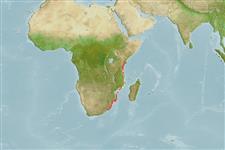Common names from other countries
Elasmobranchii (tubarões e raias) (sharks and rays) >
Rhinopristiformes (Shovelnose rays) >
Rhinobatidae (Guitarfishes)
Etymology: Rhinobatos: Greek, rhinos = nose + Greek, batis, -idos = a ray (Raja sp.) (Ref. 45335).
More on author: Norman.
Environment: milieu / climate zone / depth range / distribution range
Ecologia
marinhas demersal; intervalo de profundidade 75 - 253 m (Ref. 11228). Deep-water; 2°S - 31°S, 30°E - 43°E (Ref. 114953)
Western Indian Ocean: Kenya to Natal, South Africa.
Tamanho / Peso / Idade
Maturity: Lm ? range ? - ? cm
Max length : 127 cm TL macho/indeterminado; (Ref. 3919)
Descrição breve
Chaves de identificação | Morfologia | Morfometria
A guitarfish with a narrow, sharply pointed snout and a narrow pectoral disc; nasal flaps extend only to the inner nostril edges (Ref. 5578). Plain olive-green above, without spots; prominent black blotch on underside of snout (Ref. 5578).
A rare and unknown species found offshore on the shelf (Ref. 5578). Ovoviviparous (Ref. 50449). Taken as bycatch of trawl and gillnet fisheries (Ref. 114953).
Life cycle and mating behavior
Maturities | Reprodução | Spawnings | Egg(s) | Fecundities | Larvas
Exhibit ovoviparity (aplacental viviparity), with embryos feeding initially on yolk, then receiving additional nourishment from the mother by indirect absorption of uterine fluid enriched with mucus, fat or protein through specialised structures (Ref. 50449).
Compagno, L.J.V., 1986. Rhinobatidae. p. 128-131. In M.M. Smith and P.C. Heemstra (eds.) Smiths' sea fishes. Springer-Verlag, Berlin. (Ref. 3919)
Categoria na Lista Vermelha da IUCN (Ref. 130435)
Ameaça para o homem
Harmless
Utilização humana
Pescarias: sem interesse
Ferramentas
Relatórios especiais
Descarregue XML
Fontes da internet
Estimates based on models
Preferred temperature (Ref.
115969): 18 - 22.3, mean 19.8 (based on 23 cells).
Phylogenetic diversity index (Ref.
82804): PD
50 = 0.5000 [Uniqueness, from 0.5 = low to 2.0 = high].
Bayesian length-weight: a=0.00295 (0.00151 - 0.00578), b=3.13 (2.96 - 3.30), in cm Total Length, based on LWR estimates for this (Sub)family-body shape (Ref.
93245).
Nível Trófico (Ref.
69278): 3.8 ±0.4 se; based on size and trophs of closest relatives
Resiliência (Ref.
120179): Baixo, tempo mínimo de duplicação da população 4,5 - 14 anos (Fec assumed to be <100).
Fishing Vulnerability (Ref.
59153): Very high vulnerability (76 of 100).
